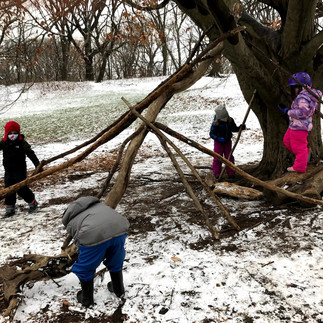Sticking with Your Friends
- Serena Krombach
- May 1, 2023
- 2 min read
Updated: May 10, 2023

“Put the stick down!” “Be careful with that stick!” We give these warnings to our kids all the time. What would happen if we didn't?
In her picture book Not a Stick, Antoinette Porter makes us keenly aware of our words, pointing out (see what I did there?!) that sticks are conduits by which kids develop their capacity for creativity and imagination. “It’s not a stick!” the pig responds; it’s a fishing pole, a horse, a magic wand, a sword for fighting dragons. The pig is pictured alone, though. Kids using sticks as swords to fight each other—that’s a different story!
When kids pretend their sticks are weapons, they risk hurting each other, there’s no way around it, and the risk goes up the more aggressive the play. But the spatial awareness this teaches is invaluable: How close can I get without hurting my friend? How close is too uncomfortable for me? And the social skills needed for safe stick play are learned by doing: practicing saying "stop!" when it's too much, and stopping when they’re asked to. These are important early lessons in consent! If adults intervene, we're keeping children from learning for themselves.
Children also turn sticks into tools to investigate the natural world. They use them to measure the depth of a puddle, balance on a log, dig a river. Stick play brings out children’s inner scientists: children form questions and hypotheses and test them—Can I get this stick to stand up on its own? Can this stick reach that branch? Do I need a longer stick? A shorter one? A thicker or thinner one? They change variables and repeat trials and store the results in memory. When kids do these experiments in pairs or in a group, their neurons fire more brightly (they'll get "lab partners" later in school for the same reason).
Yet here, too, and especially with those longer branches, they run the risk of injury to others, and accidents happen. Young children’s black-and-white thinking makes it hard for them to recover: the one hurt gets upset and accusatory, the one who caused it (if there was only one, sometimes it's both!) feels victimized. To learn to brush off accidents the way adults can, children need to experience them, and then work through the ambiguity of no one being at fault. Of course, the first order of business has to be attending to a severe injury—but still, we can wait to step in. Children often have outsize reactions to smaller hurts, especially in the presence of an adult. And by waiting you might just see another child doing the investigating and showing compassion.
What if it's not just other kids in the path of danger? That’s when it's really hard not to say something! One day in the park heading over to the meadow, I watched the kids swinging their sticks as they walked down the stairs—where someone was sitting in the way. I held my tongue, held my breath. . . . The kids, animatedly chatting, brought the sticks closer to their bodies. All on their own, they judged what space they had and did what they needed to keep everyone safe, without one word of warning!













Comments